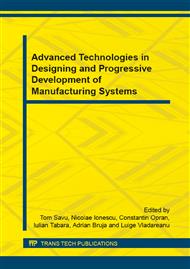p.281
p.287
p.293
p.299
p.305
p.311
p.317
p.323
p.329
The Automotive Vibrations Effect on the Comfort Degree Determined at the Level of Foot-Shoe Composite Structure
Abstract:
A number of issues related to the effect of vibration analysis, developed inside a car, the comfort level led to the composite structure of the whole foot and shoes is presented in this paper. Variants of composite structures consisting of biomechanical system - the human body, foot and shoe variants that undergo analysis are presented in the first part of the paper. Also human body models are presented and analyzed in connection with the surface and place inside the car driving. This study aims to determine the physiological limits of stability of the locomotor system, barefoot and wearing shoes, with or without insoles, over a period of time the car is driven. The experimental system and methodology for analysis are described in the second part of the paper. The third part of the paper presents the results and conclusions obtained from this study and determining the postural comfort degree (PCD).
Info:
Periodical:
Pages:
305-310
Citation:
Online since:
May 2015
Authors:
Keywords:
Price:
Сopyright:
© 2015 Trans Tech Publications Ltd. All Rights Reserved
Share:
Citation:


